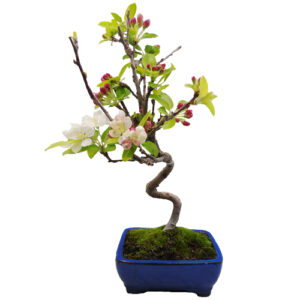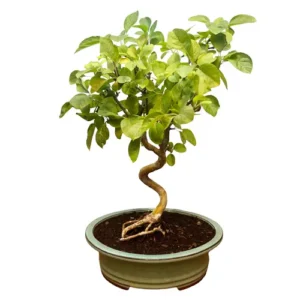crab apple bonsai tree
Crab apple (malus)
The Crab Apple is a small deciduous tree which produces bright pink buds that open to white flowers. In the autumn these flowers change to tiny apples which sometimes hang on the tree for longer than the leaves.
Placement
The Crab Apple is a hardy species that requires a lot of light and airflow to discourage mildew problems. Look for a spot that receives bright and full sun and note that it will not survive being kept indoors. Over winter, your Crab Apple bonsai tree will need some protection from frost and we recommend using a cold frame or bringing it indoors to an unheated space such as a greenhouse.
Watering
There is no definitive guide to watering and it should be conducted on an observational schedule, not a routine. This means that it is important to keep an eye on the moisture levels of the soil to avoid over and under watering, both which can lead to dropping leaves and/or root death. The amount of water a bonsai requires depends on pot size, climate, airflow, soil and tree type so it is best to use your eyes and fingers to assess whether the soil is damp, wet or dry.
If the top inch or so of soil has dried, it is ready to be watered. When you water, ensure an even coverage over the roots and soil, allowing water to flow out from the bottom of the pot to ensure a good soaking. If you are a first-time bonsai owner, another good way to water is by submerging the entire pot in water until the bubbles stop. If you choose this method, be aware that your bonsai may not need watering for another two or three days, but this will depend on the factors mentioned above.
Be extra stringent when the tree is fruiting and water well; if it is allowed to dry up, the Crab Apple’s fruits will shrivel and drop off.
Fertilising
Using fertiliser on your Crab Apple bonsai tree will help encourage healthy growth and this should be done periodically from once a week to every two months and only during the growing season. You can start adding Chrystal Liquid Bonsai Feed to your water from March until October and use weekly. Use Naruko Fertiliser Slow Release Bonsai Feed once every one to two months. With bonsai trees, less is more, and we tend to advise using half the recommended dosage to see how your bonsai reacts first.
Using a very nitrogen-rich feed before, after or during flowering will encourage leaf and stem growth at the expense of fruiting. If growth is required over fruit, continue to feed fortnightly.
This would be useful every other year, as it is recommended that you only let your Crab Apple bonsai tree fruit once every two to three years to avoid weakening the tree.
Pruning and wiring
Pruning your bonsai is important not only to maintain or create an aesthetic style but to also to manipulate the production of flowers and fruits.
In the spring, you can cut new shoots back to one or two leaves left on the stem. You should also remove fruits if there are too many because they weaken the tree. Remove all but one from each cluster.
After that, wait until late summer and autumn to prune, or until the leaves have fallen off, as this will avoid confusion between stems and flower buds. If you do not want your Crab Apple bonsai tree to produce fruits that year, cut off the flowers as soon as they die.
Training your Crab Apple bonsai tree using wiring is possible on the younger, suppler branches but training older ones should be conducted with great care as the wood is very brittle. We recommend using wires with a thickness that matches the thickness of the branch: If the wire you choose is too thick you will damage the bark. If it is too thin, it won’t be effective
Repotting
Repotting your tree is an important way to provide a fresh and suitable soil mix and ensure appropriate root health. Repot in spring time before the first signs of new growth. Generally, your Crab Apple will need to be re-potted annually if it is young, while older ones can stay in their pots for longer. However, you should always check if it has become root-bound before you change pots. You can do this by lifting the tree gently out of the pot by the main trunk and examining the root system. You will know it is ready if you can see that the roots are circling around each other and the pot. If, however, they still appear contained in the soil, you should place it back and wait until the following spring to check again.
The Crab Apple can withstand some considerable root pruning, and this would benefit the tree’s health. It is important that the soil mix you choose for the new pot is well-draining and we tend to use a mixture of different speciality bonsai soils on our trees. Every species is different so please contact us for free soil-mix advice or to take advantage of our re-potting service, visit www.miyagibonsai.co.uk/services/.
Choose a pot that is slightly bigger, reflects the tree’s style, leaf and bark colour and is a suitable material.
For further information and advice on your bonsai tree, please refer to our blog at ………..
For tools, fertilisers, soils, pots and other accessories please visit…….
crab apple bonsai tree
Showing all 2 results


